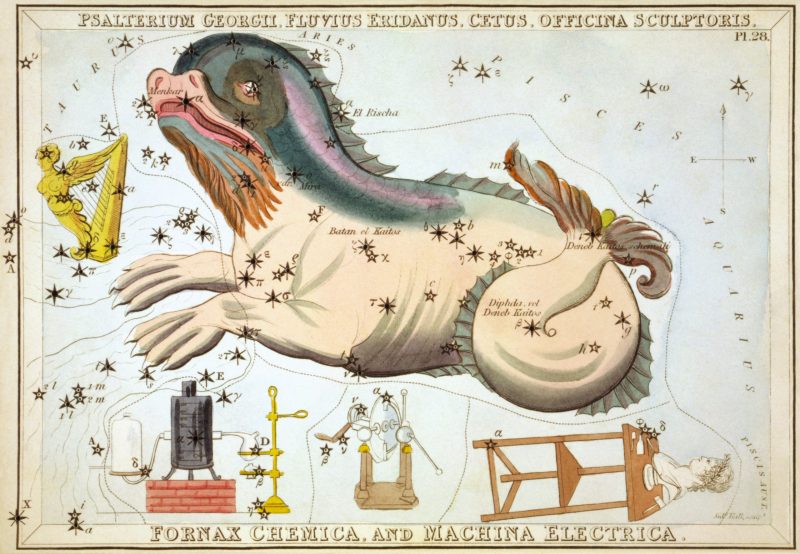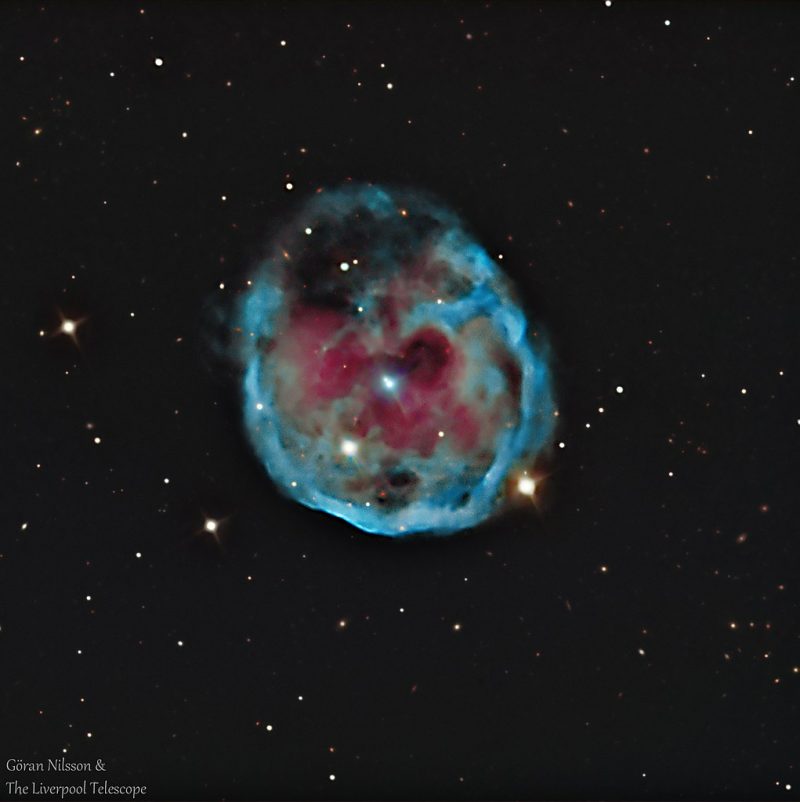
Cetus the Whale is a long constellation that rises in the east-southeast on fall evenings. It’s the fourth largest of the 88 constellations, losing out only to Ursa Major, Virgo and Hydra. Cetus lies below Pisces the Fish and Eridanus the River to create a pleasing sea-themed area of the night sky. From December 11 to 14, 2021, the moon will pass above Cetus, starting near the tail, crossing above the body and ending near the whale’s head. This gives you a great opportunity to locate and learn some of its stars.
The mythology of Cetus
In Greek mythology, Cetus was a fearsome sea monster. Cetus nearly ate Andromeda the Chained Lady before Perseus arrived and saved the day, slaying Cetus. Depending on the myth you read, Cetus either meets its fate on the sword of Perseus or by turning to stone after viewing the severed head of Medusa.

The Stars of Cetus the Whale
The brightest star in the head of Cetus is Menkar, shining at magnitude 2.54. It’s the second brightest star in Cetus and also goes by the name Alpha Ceti. The star that marks where the whale’s head joins its neck is the 3.47-magnitude star Kaffaljidhma, or Gamma Ceti. Moving toward the body of the whale is Delta Ceti at magnitude 4.08. Delta will be useful later for finding Cetus’ one prominent galaxy.
The next star in the body of the whale is the famous Mira, with the nickname of The Wonderful. Mira, or Omicron Ceti, is a popular variable star, which is one that changes in brightness. This long-period variable star can get as bright as magnitude 2 and as dim as magnitude 10. When you compare it to the other stars in Cetus, how bright does Mira look tonight? Another curious feature of Mira is that it is rushing through space at 290,000 miles per hour (130 km/s). This immense speed and the fact that Mira is nearing the end of its life and ejecting material means the wonderful star sports a tail that stretches for an incredible 13 light-years.
The brightest star in Cetus goes by three different names: Beta Ceti, Diphda and Deneb Kaitos. This star shines at magnitude 2.0 and lies in the tail of the beast.
Galaxies in Cetus the Whale
The one Messier object in Cetus is the galaxy M77. It lies just a degree east-southeast of the star Delta Ceti. M77 shines at magnitude 8.8 from 47 million light-years away. The face-on spiral galaxy has an active galactic nucleus and a noticeably bright center. Those with large telescopes may be able to catch another galaxy between Delta Ceti and M77. The magnitude-10.6 galaxy NGC 1055 resides there.

Nebulae in Cetus the Whale
One notable planetary nebula lies six degrees north of the brightest star Diphda, or Deneb Kaitos. NGC 246 has a magnitude of 8. The nebula has a bubble- or ring-shaped appearance. Planetary nebulae come into being when stars puff off material toward the end of their lives. Mira will eventually create another planetary nebula in Cetus when it ends its life and ejects its remaining gas. As a fitting moniker for a star that has given up the ghost, NGC 246 also bears the nickname of the Skull Nebula.

Bottom line: Cetus the Whale is a huge constellation that swims in a sea of stars near constellations named for a river and fish. Its most notable star is Mira the Wonderful.
The post Cetus the Whale swims in a celestial sea first appeared on EarthSky.
from EarthSky https://ift.tt/3GS2REf

Cetus the Whale is a long constellation that rises in the east-southeast on fall evenings. It’s the fourth largest of the 88 constellations, losing out only to Ursa Major, Virgo and Hydra. Cetus lies below Pisces the Fish and Eridanus the River to create a pleasing sea-themed area of the night sky. From December 11 to 14, 2021, the moon will pass above Cetus, starting near the tail, crossing above the body and ending near the whale’s head. This gives you a great opportunity to locate and learn some of its stars.
The mythology of Cetus
In Greek mythology, Cetus was a fearsome sea monster. Cetus nearly ate Andromeda the Chained Lady before Perseus arrived and saved the day, slaying Cetus. Depending on the myth you read, Cetus either meets its fate on the sword of Perseus or by turning to stone after viewing the severed head of Medusa.

The Stars of Cetus the Whale
The brightest star in the head of Cetus is Menkar, shining at magnitude 2.54. It’s the second brightest star in Cetus and also goes by the name Alpha Ceti. The star that marks where the whale’s head joins its neck is the 3.47-magnitude star Kaffaljidhma, or Gamma Ceti. Moving toward the body of the whale is Delta Ceti at magnitude 4.08. Delta will be useful later for finding Cetus’ one prominent galaxy.
The next star in the body of the whale is the famous Mira, with the nickname of The Wonderful. Mira, or Omicron Ceti, is a popular variable star, which is one that changes in brightness. This long-period variable star can get as bright as magnitude 2 and as dim as magnitude 10. When you compare it to the other stars in Cetus, how bright does Mira look tonight? Another curious feature of Mira is that it is rushing through space at 290,000 miles per hour (130 km/s). This immense speed and the fact that Mira is nearing the end of its life and ejecting material means the wonderful star sports a tail that stretches for an incredible 13 light-years.
The brightest star in Cetus goes by three different names: Beta Ceti, Diphda and Deneb Kaitos. This star shines at magnitude 2.0 and lies in the tail of the beast.
Galaxies in Cetus the Whale
The one Messier object in Cetus is the galaxy M77. It lies just a degree east-southeast of the star Delta Ceti. M77 shines at magnitude 8.8 from 47 million light-years away. The face-on spiral galaxy has an active galactic nucleus and a noticeably bright center. Those with large telescopes may be able to catch another galaxy between Delta Ceti and M77. The magnitude-10.6 galaxy NGC 1055 resides there.

Nebulae in Cetus the Whale
One notable planetary nebula lies six degrees north of the brightest star Diphda, or Deneb Kaitos. NGC 246 has a magnitude of 8. The nebula has a bubble- or ring-shaped appearance. Planetary nebulae come into being when stars puff off material toward the end of their lives. Mira will eventually create another planetary nebula in Cetus when it ends its life and ejects its remaining gas. As a fitting moniker for a star that has given up the ghost, NGC 246 also bears the nickname of the Skull Nebula.

Bottom line: Cetus the Whale is a huge constellation that swims in a sea of stars near constellations named for a river and fish. Its most notable star is Mira the Wonderful.
The post Cetus the Whale swims in a celestial sea first appeared on EarthSky.
from EarthSky https://ift.tt/3GS2REf

Aucun commentaire:
Enregistrer un commentaire